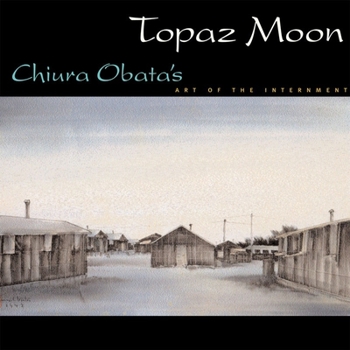Topaz Moon: Chiura Obata's Art of the Internment
Chiura Obata was one of more than 100,000 Japanese Americans forcefully relocated from their homes, work, and communities to the stark barracks of desert internment camps during World War II. As an artist faithfully recording the world around him, Obata's work from this period gives us a view into the camps that is at once honest and strikingly lyrical. Topaz Moon brings together more than 100 paintings and sketches from Obata's internment...
Format:Paperback
Language:English
ISBN:1890771260
ISBN13:9781890771263
Release Date:March 2000
Publisher:Heyday Books
Length:168 Pages
Weight:1.03 lbs.
Dimensions:0.4" x 8.2" x 8.2"
Customer Reviews
4 ratings
"Topaz Moon": The Great Nature of Chiura Obata
Published by Thriftbooks.com User , 19 years ago
"Topaz Moon" is a slim little book that is filled with a selection of the interment imagery of Chiura Obata. The imagery is both in his writings and in his art. And both make lasting impressions. The images range from simple line drawing to watercolors executed while a victim of Executive Order 9066 in which all West Coast Japanese Americans were rounded up and placed in interment camps. It is amazing what he was able to accomplish in the face of circumstances beyond his control. Obata's work is excellent. "Topaz Moon", "Obata's Yosemite" and "Nature Art With Chiura Obata" are the only three books currently in print about the remarkable artist and human being that was Chiura Obata. The three books present different facets of his life and all are worth reading and seeing. Highly recommended.
Great art and great social history
Published by Thriftbooks.com User , 24 years ago
This is a wonderful book. I bought it for the artwork which is fresh, inventive, and very skillful but the social history is equally engrossing. The text is clearly written and generous with quotes.At 8.25" square it's smaller than your average coffee table book, but the pages are rich with intelligence, beauty and invention.
Great for educating children about Executive Order 9066.
Published by Thriftbooks.com User , 24 years ago
Most of the artwork are done in black ink on white paper. It makes for a stark and bleak testament to the difficulties faced and endured by the internees. The book is a great teaching tool for children and adults, not only to learn about the internment, but to study the artwork.
A compelling and fascinating work
Published by Thriftbooks.com User , 24 years ago
Topaz Moon is a testament to the power of art, not simply as a mechanism for creating beauty, but also as a method of documenting history. Faced with the social disruption and indignity of relocation and internment in WWII, Professor Chiura Obata of the University of California at Berkeley chose to use his considerable artistic gifts to create what amounts to a visual diary of his internment experience. Seemingly hundreds of drawings, pen and ink paintings and watercolors (too many to count) document Professor Obata and his families experiences from the start of the war, through relocation to Tanforan, internment at Topaz, and beyond, in stark terms, quiet dignity and haunting beauty. Unlike photography which can only memorialize the actual events of a moment, painting and sketching allows the artist to document his or her own emotional reaction to those events. Dorothea Lange, herself an admirer of Professor Obata, took photographs of the Tanforan relocation center, including Professor Obata's art classes, some of which are reproduced in Topaz Moon. However, compared to Professor Obata's own first hand sketches of the internment process, Lange's photos appear emotionless. This is because Professor Obata infuses his documentary sketches, which are remeniscent of Van Gogh's figural drawings, with the powerful emotional reactions he felt in witnessing scenes in which he too was a victim.But Topaz Moon is a text which is more about creating community than casting blame. Kimi Kodani Hill, Professor Obata's granddaughter, has framed her grandfather's art with an insightful, succinct and compelling history of Professor Obata's life and the events of the time. The anectdotes relayed by Ms. Hill emphasize the support, assistance and sympathy given to the Obata's by their many freinds outside of the camps. I was struck by the fact the President of U.C. Berkeley, Robert Gordon Sproul, who himself was vocally opposed to the internment, personally rescued Professor Obata's life's work of art and stored that art in his official U.C. residence for the duration of the war. While Topaz Moon is more than an art book, the art itself is more than merely documentary. Professor Obata's finished paintings and sumi-e works represent some of the best American artwork of the 20th Century. Works such as Moonlight Over Topaz (commissioned by Eleanor Roosevelt while Professor Obata was still interred), Hospital Topaz, and Silent Moonlight at Tanforan Relocation Center would stand out in any museum. In their own way, these images are every bit as beautiful as his earlier Yosemite woodblock prints.I highly recommend this book.






